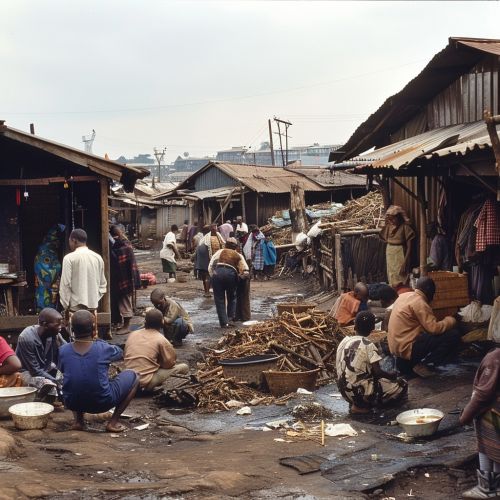Poverty and Inequality
Introduction
Poverty and inequality are two deeply interconnected social phenomena that have significant implications for individuals, communities, and nations. Poverty refers to the state of having insufficient financial resources to meet basic living needs, such as food, shelter, and healthcare. Inequality, on the other hand, pertains to the uneven distribution of resources and opportunities among different groups within a society. This article delves into the complexities of poverty and inequality, examining their causes, consequences, and potential solutions.
Definitions and Concepts
Poverty
Poverty is often measured using various thresholds, such as the poverty line, which defines the minimum income level required to secure the necessities of life. Absolute poverty refers to a condition where individuals lack the basic means to survive, while relative poverty considers the economic status of individuals in relation to the broader society. The World Bank and other international organizations frequently use these metrics to assess and compare poverty levels across different countries.
Inequality
Inequality encompasses disparities in income, wealth, education, and access to essential services. It can be categorized into economic inequality, social inequality, and political inequality. Economic inequality refers to the gap between the rich and the poor in terms of income and wealth. Social inequality involves differences in access to resources such as education and healthcare, while political inequality pertains to the unequal influence individuals or groups have over political processes and decisions.
Causes of Poverty and Inequality
Economic Factors
Economic factors play a crucial role in perpetuating poverty and inequality. These include unemployment, underemployment, and low wages. Globalization and technological advancements have also contributed to economic disparities by favoring skilled labor and capital over unskilled labor. Additionally, economic policies such as austerity measures and tax structures can exacerbate income inequality.
Social Factors
Social factors such as discrimination, lack of education, and poor healthcare access significantly contribute to poverty and inequality. Discrimination based on race, gender, or ethnicity can limit opportunities for certain groups, leading to persistent economic and social disadvantages. Education is a critical determinant of economic mobility, and inadequate access to quality education can trap individuals in a cycle of poverty.
Political Factors
Political factors, including governance, corruption, and policy decisions, also influence poverty and inequality. Weak governance and corruption can divert resources away from essential services, exacerbating poverty. Policy decisions, such as those related to social welfare programs and labor laws, can either mitigate or worsen economic disparities.
Consequences of Poverty and Inequality
Health Impacts
Poverty and inequality have profound effects on health outcomes. Individuals living in poverty are more likely to experience malnutrition, chronic diseases, and limited access to healthcare services. Inequality can lead to disparities in health outcomes, with marginalized groups often facing higher rates of morbidity and mortality.
Social Impacts
The social consequences of poverty and inequality include increased crime rates, social unrest, and reduced social cohesion. High levels of inequality can erode trust within communities and lead to social fragmentation. Poverty can also limit individuals' ability to participate fully in society, perpetuating cycles of disadvantage.
Economic Impacts
Economically, poverty and inequality can hinder growth and development. High levels of inequality can reduce social mobility and limit the potential for economic innovation. Poverty can also strain public resources, as governments may need to allocate significant funds to social welfare programs and healthcare services.
Solutions and Interventions
Economic Policies
Implementing progressive economic policies can help address poverty and inequality. These include raising the minimum wage, implementing progressive taxation, and investing in job creation programs. Social safety nets, such as unemployment benefits and food assistance programs, can provide immediate relief to those in poverty.
Education and Training
Improving access to quality education and vocational training is essential for reducing poverty and inequality. Education can enhance individuals' skills and employability, leading to better job opportunities and higher incomes. Policies aimed at reducing educational disparities can promote social mobility and economic equality.
Healthcare Access
Ensuring access to affordable healthcare is crucial for addressing the health impacts of poverty and inequality. Universal healthcare systems can provide comprehensive coverage and reduce financial barriers to medical services. Public health initiatives aimed at addressing social determinants of health can also mitigate health disparities.
Social and Political Reforms
Social and political reforms are necessary to address the root causes of poverty and inequality. These include anti-discrimination laws, gender equality initiatives, and measures to improve governance and reduce corruption. Empowering marginalized groups through political participation and representation can also promote more equitable policy decisions.
Case Studies
Brazil
Brazil is a country that has experienced significant economic growth alongside persistent inequality. Despite efforts to reduce poverty through social programs such as Bolsa Família, income inequality remains high. Factors contributing to this include unequal access to education and healthcare, as well as regional disparities.
India
India has made strides in reducing poverty through economic reforms and social programs. However, inequality remains a challenge, particularly in rural areas. Disparities in education, healthcare, and employment opportunities contribute to ongoing economic and social inequalities.
Sweden
Sweden is often cited as an example of a country with low levels of poverty and inequality. This is attributed to its comprehensive welfare state, progressive taxation, and strong labor market policies. However, recent trends indicate a rise in income inequality, highlighting the need for ongoing policy attention.
See Also
- Social Determinants of Health
- Economic Mobility
- Social Safety Net
- Universal Basic Income
- Progressive Taxation


